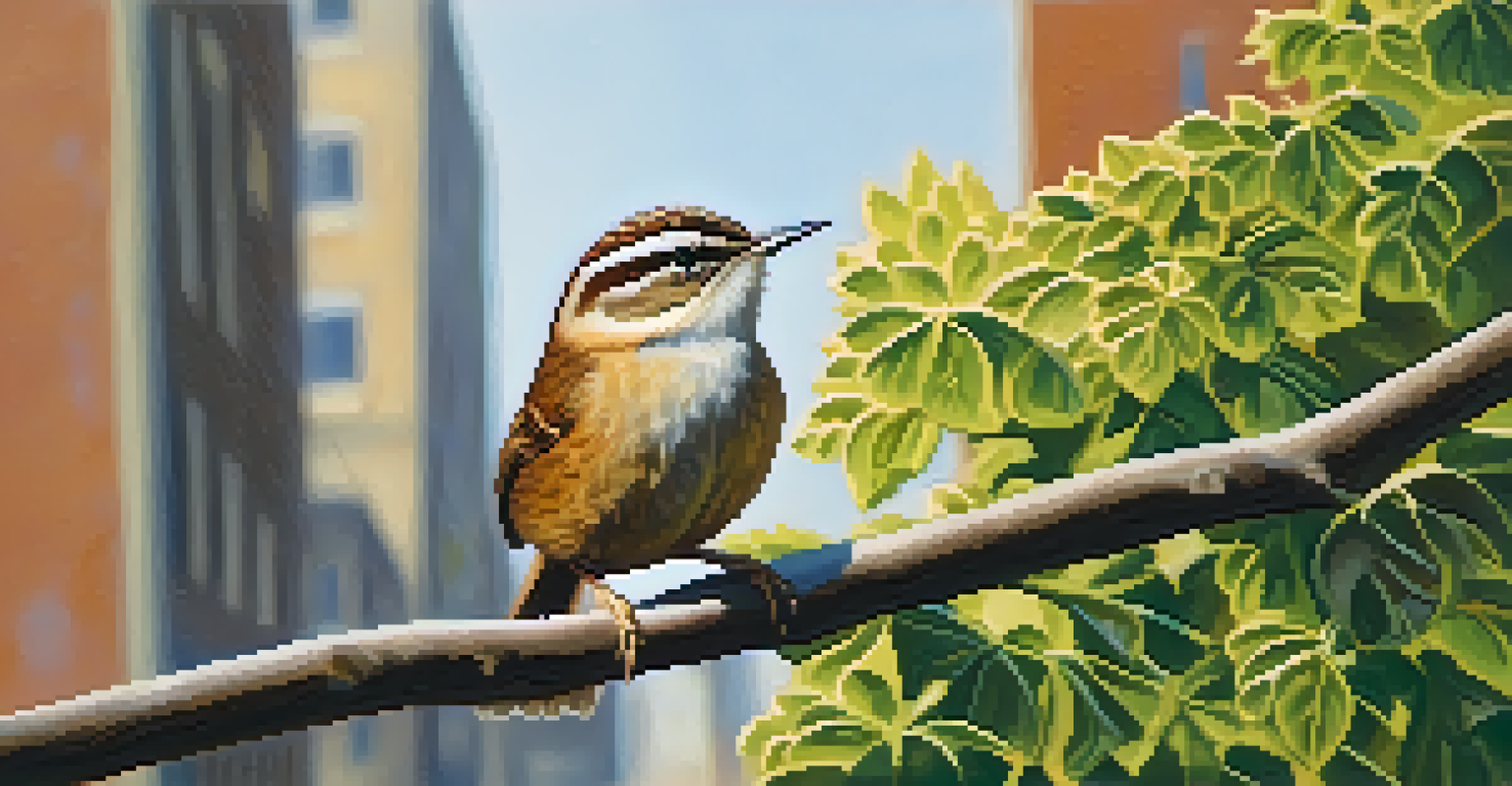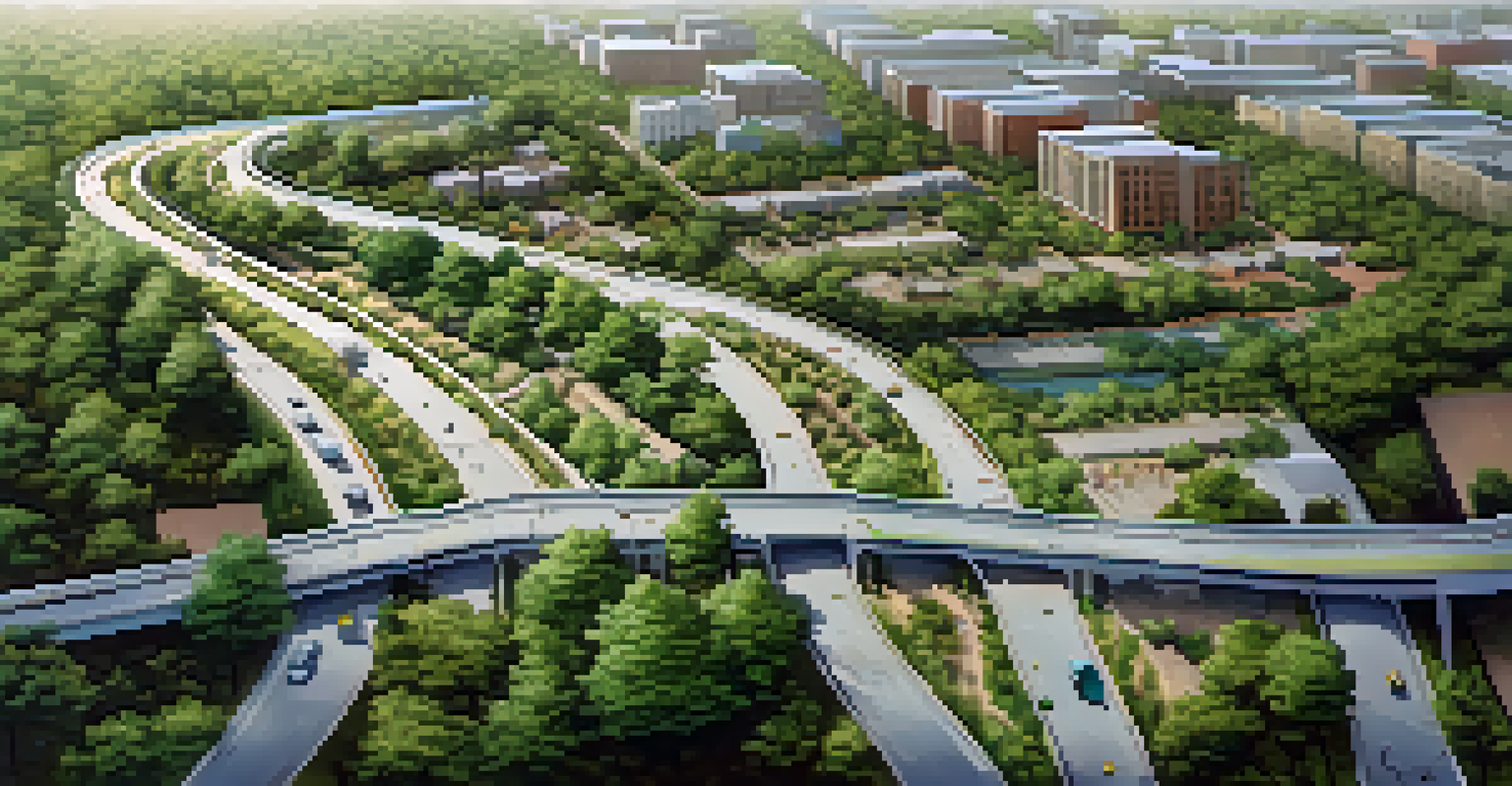Impact of Urbanization on Charlotte's Native Wildlife Species

Understanding Urbanization in Charlotte
Urbanization refers to the increasing population in cities, which often leads to the expansion of infrastructure and housing. In Charlotte, this growth has been rapid, transforming the landscape from lush greenery to bustling neighborhoods. As more people move to the city, the demand for land and resources intensifies, inevitably affecting local ecosystems.
In nature, nothing exists alone.
With Charlotte being one of the fastest-growing cities in the United States, this urban sprawl has significant implications for wildlife. Forests and wetlands are being replaced by roads and buildings, disrupting the habitats that many native species rely on. This transformation not only alters the physical environment but also impacts the delicate balance of local wildlife populations.
Understanding how urbanization reshapes Charlotte is crucial to addressing its effects on native species. As we delve deeper into the consequences of this growth, we’ll see how both wildlife and urban environments can coexist, and what measures can be taken to create a more harmonious relationship.
Loss of Habitat and Its Consequences
One of the most immediate effects of urbanization is habitat loss. As forests, wetlands, and fields are cleared for new developments, many species lose their homes and food sources. For instance, the Carolina Wren, a common bird in the area, finds its nesting sites threatened by the encroachment of urban structures.

This loss of habitat can lead to decreased biodiversity, as some species struggle to adapt to new environments. When native animals can no longer thrive, it creates an imbalance in the ecosystem. Predators and prey that once relied on each other may find themselves in a struggle for survival, leading to a ripple effect throughout the food chain.
Urbanization Threatens Wildlife
Rapid urban growth in Charlotte leads to habitat loss and challenges for local wildlife, disrupting ecosystems and native species.
Moreover, isolated patches of habitat can result in 'edge effects,' where the conditions at the edges of these areas differ markedly from those deeper inside. This can expose species to predators and other stresses, further complicating their survival in an urban setting.
Fragmentation of Ecosystems
Urbanization often leads to the fragmentation of ecosystems, breaking up large continuous habitats into smaller, isolated patches. This fragmentation makes it difficult for wildlife to migrate, find mates, and access food sources. For example, the Eastern Box Turtle, once common in Charlotte, faces challenges in finding suitable habitats due to roads and developments that divide their living spaces.
The environment is where we all meet; where we all have a mutual interest; it is the one thing all of us share.
As ecosystems become fragmented, the genetic diversity of species can also diminish. When populations are cut off from one another, the likelihood of inbreeding increases, which can weaken the overall health of these species. This reduction in genetic diversity makes them more vulnerable to diseases and environmental changes.
In a city like Charlotte, where green spaces are often limited, understanding the implications of fragmentation is vital. It highlights the need for wildlife corridors and protected areas that can help bridge these gaps, allowing for safer passage and healthier populations.
Invasive Species and Their Impact
Urban environments often make it easier for invasive species to thrive. These non-native species can outcompete local wildlife for food and resources, leading to declines in native populations. For example, the introduction of the Northern Snakehead fish in local waters poses a threat to native fish species by preying on them and competing for habitat.
Invasive plants, such as kudzu, can also disrupt local ecosystems by outgrowing and overshadowing native flora. This can lead to a decrease in food availability for local herbivores and, consequently, the predators that rely on them. The impacts of invasive species can cascade through the food web, affecting various levels of the ecosystem.
Ecosystem Fragmentation Issues
The fragmentation of ecosystems in urban areas makes it difficult for wildlife to migrate and maintain genetic diversity.
To mitigate the effects of invasive species, it's crucial for urban planners and conservationists to work together. By promoting public awareness and encouraging the removal of these invaders, Charlotte can protect its native wildlife and maintain its ecological integrity.
Changes in Food Availability
Urbanization alters the natural food web, leading to changes in food availability for various wildlife species. As native plants are replaced by ornamental landscaping and urban gardens, the natural sources of food for local wildlife diminish. Birds like the American Robin may struggle to find their preferred fruits and insects when their habitats are transformed.
Additionally, urban areas often lead to an increase in human-related food sources, which can attract species not typically found in the area. Raccoons and opossums, for example, may thrive in urban settings due to the availability of trash and discarded food, leading to competition for resources with native species.
Finding a balance between human development and wildlife needs is essential for maintaining a healthy ecosystem. Understanding these changes in food availability can help inform conservation strategies and urban planning efforts to better support Charlotte's native wildlife.
Urban Wildlife Adaptation Strategies
Despite the challenges posed by urbanization, many wildlife species have shown remarkable adaptability. For instance, species like the Red-tailed Hawk have adjusted to urban environments by nesting on tall buildings and hunting in parks. This adaptability illustrates the resilience of nature, even in the face of significant environmental changes.
Some animals have even changed their behaviors to thrive in urban settings. Squirrels may become more reliant on human-provided food sources, while certain bird species modify their calls to communicate better amid city noise. These adaptations can provide insights into how wildlife can coexist with urban development.
Community Role in Conservation
Community involvement is crucial for conservation efforts, helping to restore habitats and promote biodiversity in urban settings.
However, while some species may thrive, not all can adapt equally. It’s essential to recognize the limits of this adaptability and work towards creating environments that support all wildlife, not just the most resilient species.
Conservation Efforts and Community Involvement
To protect Charlotte's native wildlife, conservation efforts are crucial. Local organizations and government initiatives are working to restore habitats, create wildlife corridors, and promote biodiversity within urban spaces. Community involvement plays a significant role in these efforts, as residents can contribute through volunteer programs and awareness campaigns.
Engaging the community in conservation not only raises awareness but also fosters a sense of responsibility towards local wildlife. Initiatives like community gardens and native plant landscaping can enhance urban environments, providing food and shelter for native species. Such efforts can bridge the gap between urban growth and wildlife preservation.

By collaborating on conservation projects, Charlotte residents can help create a city that honors both its natural heritage and its urban progress. Together, these efforts can ensure that wildlife continues to thrive amidst the changes brought by urbanization.
Future Outlook for Charlotte's Wildlife
As Charlotte continues to grow, the future of its native wildlife hangs in the balance. The ongoing challenge is to find sustainable solutions that allow for urban development while protecting the habitats of local species. By prioritizing ecological considerations in urban planning, the city can create spaces where wildlife and humans can coexist harmoniously.
Innovative approaches, such as green roofs, urban parks, and wildlife crossings, can provide essential habitats and corridors for wildlife in the city. These solutions not only benefit the environment but also enhance the quality of life for residents, making Charlotte a more vibrant and sustainable community.
Ultimately, the future of Charlotte's wildlife depends on the collective efforts of its citizens, conservationists, and urban planners. By fostering a culture of conservation and awareness, Charlotte can pave the way for a thriving urban ecosystem that honors its rich natural heritage.